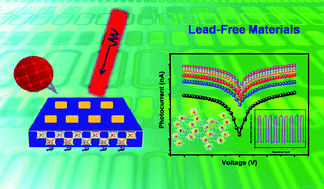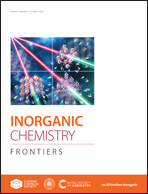A chiral lead-free photoactive hybrid material with a narrow bandgap†
Abstract
Organic–inorganic hybrid perovskites, most remarkably CH3NH3PbI3, have drawn a worldwide range of attention due to their great potential in optoelectronic and photovoltaic applications. Nevertheless, the concern on the toxicity of the lead (Pb) element in chemical composition deserves to be addressed before it is further commercialized. In the present study, a new lead-free hybrid perovskite-like compound, namely (C5H11N3)SbI5 (1, where C5H11N32+ is histaminium), has been synthesized and belongs to the chiral space group, P212121. Structurally, 1 features a distinct perovskite-type architecture of one-dimensional (1D) zigzag chains formed by the corner-sharing SbI6 octahedra with organic histaminium cations linked to the 1D chain framework via strong N–H⋯I hydrogen bonds. It is noteworthy to mention that 1 enables a wide absorption cutoff at 693 nm, corresponding to the narrow optical bandgap (Eg) of ∼1.79 eV. Consequently, the distinct semiconducting behaviors and notable photoresponses in the visible-light range have been observed in 1, of which the photocurrent on/off ratio reaches up to ∼100 under light illumination at 650 nm. Density functional theory calculation reveals that the 1D zigzag chains formed by inorganic SbI6 octahedra determine its electronic structure and photoelectric activities. In addition to the excellent repeatability of photo-induced currents, 1 also demonstrates superior phase stability and thermal stability. We believe that this study throws light on the further exploration of new lead-free hybrid perovskites for optoelectronic applications.



 Please wait while we load your content...
Please wait while we load your content...